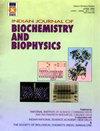结肠癌细胞中的磷脂重塑和类二十烷信号传导。
IF 1.5
4区 生物学
Q4 BIOCHEMISTRY & MOLECULAR BIOLOGY
Indian journal of biochemistry & biophysics
Pub Date : 2014-12-01
引用次数: 0
摘要
磷脂重塑和类二十烷合成是脂基炎症反应的核心。研究表明,脂肪酸通过去酰化/再酰化反应对膜磷脂进行重塑,使细胞产生过多的炎性类二十烷,如前列腺素、血栓烷和白三烯,从而增加结直肠癌(CRC)的风险。多年来,人们一直在努力了解脂质重塑途径,并设计针对类二十烷类生物合成酶的抗癌药物。本文就结直肠癌中磷脂重塑和类二十烷酸生物合成的研究进展进行综述。本文章由计算机程序翻译,如有差异,请以英文原文为准。

Phospholipid remodeling and eicosanoid signaling in colon cancer cells.
Phospholipid remodeling and eicosanoid synthesis are central to lipid-based inflammatory reactions. Studies have revealed that membrane phospholipid remodeling by fatty acids through deacylation/reacylation reactions increases the risk of colorectal cancers (CRC) by allowing the cells to produce excess inflammatory eicosanoids, such as prostaglandins, thromboxanes and leukotrienes. Over the years, efforts have been made to understand the lipid remodeling pathways and to design anti-cancer drugs targeting the enzymes of eicosanoid biosynthesis. Here, we discuss the recent progress in phospholipid remodeling and eicosanoid biosynthesis in CRC.
求助全文
通过发布文献求助,成功后即可免费获取论文全文。
去求助
来源期刊

Indian journal of biochemistry & biophysics
生物-生化与分子生物学
CiteScore
2.90
自引率
50.00%
发文量
88
审稿时长
3 months
期刊介绍:
Started in 1964, this journal publishes original research articles in the following areas: structure-function relationships of biomolecules; biomolecular recognition, protein-protein and protein-DNA interactions; gene-cloning, genetic engineering, genome analysis, gene targeting, gene expression, vectors, gene therapy; drug targeting, drug design; molecular basis of genetic diseases; conformational studies, computer simulation, novel DNA structures and their biological implications, protein folding; enzymes structure, catalytic mechanisms, regulation; membrane biochemistry, transport, ion channels, signal transduction, cell-cell communication, glycobiology; receptors, antigen-antibody binding, neurochemistry, ageing, apoptosis, cell cycle control; hormones, growth factors; oncogenes, host-virus interactions, viral assembly and structure; intermediary metabolism, molecular basis of disease processes, vitamins, coenzymes, carrier proteins, toxicology; plant and microbial biochemistry; surface forces, micelles and microemulsions, colloids, electrical phenomena, etc. in biological systems. Solicited peer reviewed articles on contemporary Themes and Methods in Biochemistry and Biophysics form an important feature of IJBB.
Review articles on a current topic in the above fields are also considered. They must dwell more on research work done during the last couple of years in the field and authors should integrate their own work with that of others with acumen and authenticity, mere compilation of references by a third party is discouraged. While IJBB strongly promotes innovative novel research works for publication as full length papers, it also considers research data emanating from limited objectives, and extension of ongoing experimental works as ‘Notes’. IJBB follows “Double Blind Review process” where author names, affiliations and other correspondence details are removed to ensure fare evaluation. At the same time, reviewer names are not disclosed to authors.
 求助内容:
求助内容: 应助结果提醒方式:
应助结果提醒方式:


